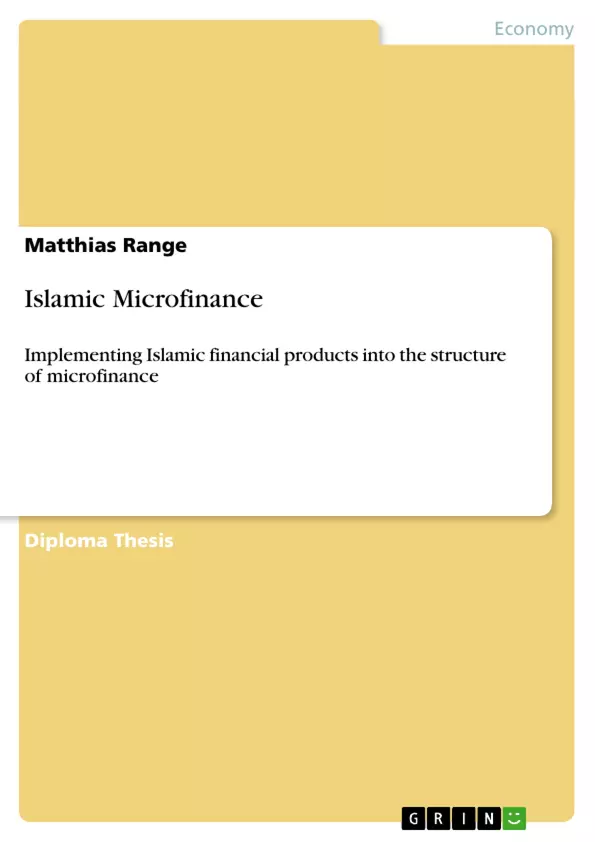The literature discussing microfinance topics like sustainability, outreach and improvement of methods as well as the role of the governments in terms of interference, supervision and regulation is getting more differentiated and substantiated. Despite this increasing interest, one aspect of microfinance has been largely neglected both scientifically and in its application: Islamic Microfinance.
In this paper I will discuss, if the principles of the Shari’ah (the Islamic law) are not somewhat compatible with the needs and obstacles of microfinance, where stewardship is to be shared and trust crucial. Further, I will discuss in detail if the prohibition of Riba is a serious, insolvable obstacle and if it is really more expensive for microfinance institutes to provide Muslims with financial services. By comparing traditional instruments of microfinance with new, transferred instruments borrowed from Islamic banking, I will try to explain – on the bases of the Islamic culture – why people are surprised about the neglect of Islamic Microfinance.
The hypotheses are as follows
• The implementation of Islamic financial products causes too high risks for microfinance institutes. The restriction of involving ‘risk’ in financial contracts for both parties by the Islam is binding. Therefore, market risks and moral hazards, make a save and steady return for the MFI not possible.
• The higher efforts of Islamic Microfinance are too much for the already weak organisation structures of MFIs. MFIs have to avoid or at least decrease market risks and moral hazards. Thus, higher efforts need to be invested by the MFIs due to the increased dependency on the success of the pre-financed projects.
• The complexity of Islamic financial products compared to convenient credit contracts leads to difficulties in both their explanation as well as their promotion in less educated areas.
Inhaltsverzeichnis (Table of Contents)
- Introduction
- 1 Microfinance ... an explanatory approach
- 1.1 Microfinance
- 1.2 The evolution of "Microfinance"
- 1.3 Why was the development of microfinance so successful?
- 1.4 Can microfinance be profitable?
- 1.5 External approach
- 1.5.1 The government's role in supporting microfinance
- 1.5.2 Regulation and supervision
- 1.5.2.1 Prudential regulation and supervision
- 1.5.2.2 Non-prudential regulation and supervision
- 1.6 Prospect and outlook
- 2 The basic principles of the Islam
- 2.1 Al-islam din wa-daula
- [The Islam is religion and state]
- 2.2 The Islam and economy
- 2.3 The emergence of Islamic banking
- 2.4 Islamic banking to microfinance
- 2.1 Al-islam din wa-daula
- 3 Islamic Banking
- 3.1 Wealth is just material
- 3.2 Of Arbaibou'l mal and Mudarribouna
- 3.2.1 [Of capital providers and clients]
- 3.2.1.1 Uqud al-Ishtirak
- [Direct Financial Accommodation]
- 3.2.1.2 Mudarabah / Muqayyadah / Qirad / Muqaradah/Commenda ...
- 3.2.1.3 Mazar'ah
- 3.2.1.4 Musharaka
- 3.2.1.5 Musaqat
- 3.2.1.1 Uqud al-Ishtirak
- 3.2.2 Uqud al Muawadhat
- 3.2.2.1 [Indirect Financial Accommodation]
- 3.2.2.2 Murabaha
- 3.2.2.3 Istishna
- 3.2.2.4 Bai al Salam
- 3.2.2.5 Ijarah
- 3.2.2.6 Benevolent Loan-Qardh ul Hasan
- 3.2.3 Al Motddakharat
- [Saving Deposits]
- 3.2.1 [Of capital providers and clients]
- 4 Islamic Microfinance
- 4.1 "People would much rather remain poor than compromise in their faith"
- 4.2 The principal agent theory and the stewardship theory
- 4.3 Risk and effort in Islamic microfinance
- 4.3.1 ... projected on direct financial accommodation
- 4.3.1.1 Specifics in Mudarabah
- 4.3.1.2 in Mazar'ah and in Musaqat
- 4.3.1.3 in Musharakah
- 4.3.2 .. projected on indirect financial accommodation
- 4.3.2.1 Specifics in Murabaha
- 4.3.2.2 in Istishna
- 4.3.2.3 in Bai al Salam
- 4.3.2.4 in ljarah
- 4.3.2.5 in Benevolent Loan-Qardh ul Hasan
- 4.3.3 ... projected on saving deposits
- 4.3.1 ... projected on direct financial accommodation
Zielsetzung und Themenschwerpunkte (Objectives and Key Themes)
This thesis aims to analyze the intersection of Islamic principles and microfinance practices. It explores the potential of Islamic microfinance to provide financial services that align with Islamic values, while also examining the challenges and opportunities presented by this unique financial model.
- The evolution and impact of microfinance
- The integration of Islamic principles into financial practices
- The potential for Islamic microfinance to promote economic development
- Challenges and opportunities in the implementation of Islamic microfinance
- The role of regulation and supervision in promoting responsible Islamic microfinance practices
Zusammenfassung der Kapitel (Chapter Summaries)
The introduction provides a general overview of microfinance and its development. Chapter 1 delves into the various aspects of microfinance, including its evolution, success factors, and the role of government regulation. Chapter 2 introduces the core principles of Islam, outlining its relationship with economic activity and the emergence of Islamic banking. Chapter 3 explores the specific mechanisms and financial tools employed in Islamic banking, focusing on various contracts and practices that align with Islamic principles. The fourth and final chapter focuses on the application of these Islamic principles to the realm of microfinance, examining the potential and challenges of Islamic microfinance in practice.
Schlüsselwörter (Keywords)
Islamic microfinance, microfinance, Islamic banking, Islamic finance, economic development, poverty alleviation, financial inclusion, Shariah compliance, risk management, ethical finance, social responsibility.
- Quote paper
- Matthias Range (Author), 2004, Islamic Microfinance, Munich, GRIN Verlag, https://www.grin.com/document/213122



